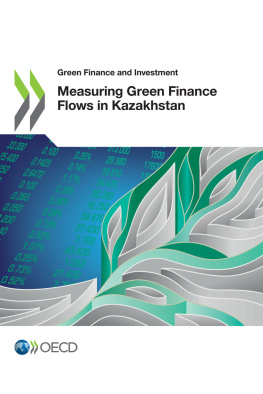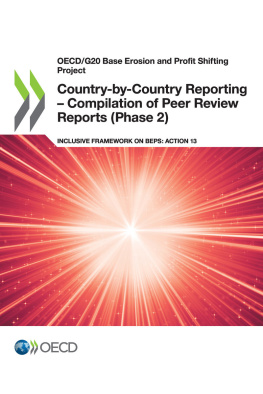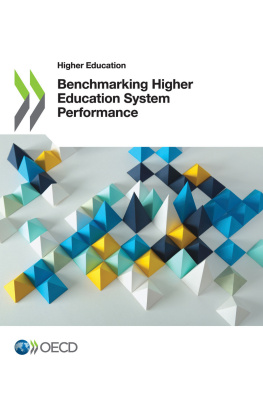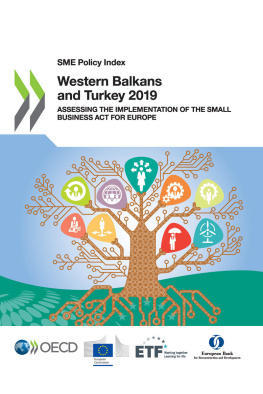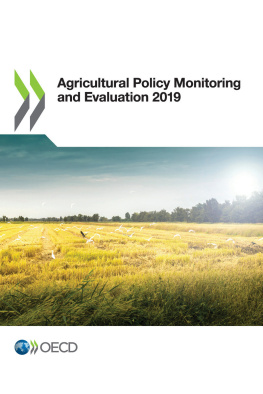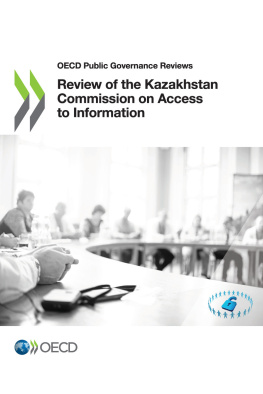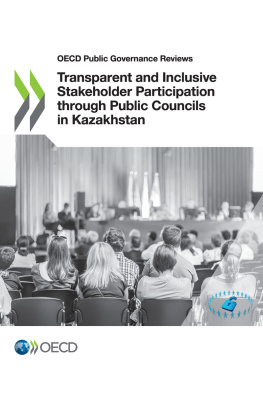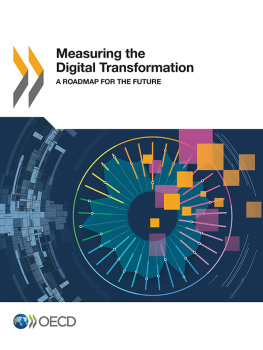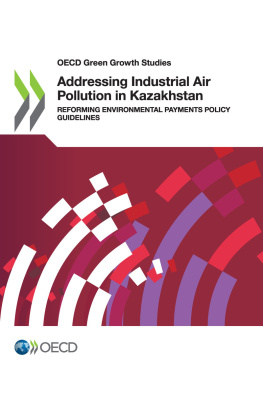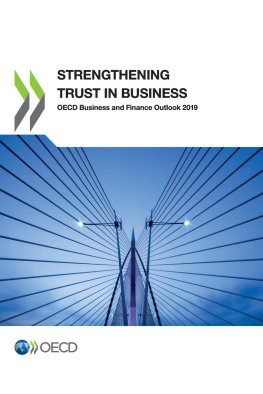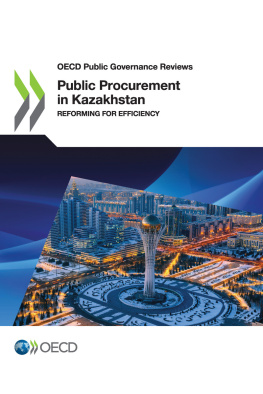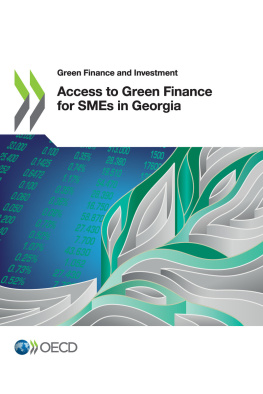OECD - Measuring Green Finance Flows in Kazakhstan
Here you can read online OECD - Measuring Green Finance Flows in Kazakhstan full text of the book (entire story) in english for free. Download pdf and epub, get meaning, cover and reviews about this ebook. year: 2020, publisher: OECD Publishing, genre: Politics. Description of the work, (preface) as well as reviews are available. Best literature library LitArk.com created for fans of good reading and offers a wide selection of genres:
Romance novel
Science fiction
Adventure
Detective
Science
History
Home and family
Prose
Art
Politics
Computer
Non-fiction
Religion
Business
Children
Humor
Choose a favorite category and find really read worthwhile books. Enjoy immersion in the world of imagination, feel the emotions of the characters or learn something new for yourself, make an fascinating discovery.
Measuring Green Finance Flows in Kazakhstan: summary, description and annotation
We offer to read an annotation, description, summary or preface (depends on what the author of the book "Measuring Green Finance Flows in Kazakhstan" wrote himself). If you haven't found the necessary information about the book — write in the comments, we will try to find it.
OECD: author's other books
Who wrote Measuring Green Finance Flows in Kazakhstan? Find out the surname, the name of the author of the book and a list of all author's works by series.
Measuring Green Finance Flows in Kazakhstan — read online for free the complete book (whole text) full work
Below is the text of the book, divided by pages. System saving the place of the last page read, allows you to conveniently read the book "Measuring Green Finance Flows in Kazakhstan" online for free, without having to search again every time where you left off. Put a bookmark, and you can go to the page where you finished reading at any time.
Font size:
Interval:
Bookmark:

OECD (2020), Measuring Green Finance Flows in Kazakhstan , Green Finance and Investment, OECD Publishing, Paris, https://doi.org/10.1787/3ef6618c-en .
The Committee on Statistics of the Ministry of National Economy of Kazakhstan has been working on the quantitative and qualitative indicators that monitor progress towards the countrys green economy transition. Using the OECD methodology on Green Growth Indicators (GGIs), the committee has identified 38 country-specific GGIs. The indicators include those on environmental protection expenditures and foreign direct investment related to green growth.
This report explores how Kazakhstans national statistical system can be further improved. These enhancements could lead to better measurement of the financial flows that contribute to the countrys green economy transition. At the same time, they would minimise the risk of creating an undue reporting burden on the private and public sector.
This report was drafted by Takayoshi Kato (OECD). Kumi Kitamori and Krzysztof Michalak (OECD) provided overall guidance. The author thanks Assel Shauenova (the Committee on Statistics), Aliya Shalabekova (the Ministry of Ecology, Geology and Natural Resources) and Aday Nygmanov (JSC Center for the Development of Trade Policy) for their thorough support in the implementation of this project, and Mireille Martini (OECD) for her contribution of Annex 3. The author is grateful for intellectual input provided by various institutions of the government of Kazakhstan: the Committee on Statistics under the Ministry of National Economy; the Ministry of Ecology, Geology and Natural Resources; and JSC Center for the Development of Trade Policy, as well as the Astana International Financial Centre. The report also greatly benefited from expert review and valuable input from colleagues at the OECD Secretariat: Alexander Dobrinevski, Guy Halpern, Raphal Jachnik, Jean-Franois Lengelle, Krzysztof Michalak, Alexandre Martoussevitch and Nelly Petkova. The author also appreciates invaluable insights provided by Florian Flachenecker (European Commission Joint Research Centre), Myriam Linster (OECD) and Andrei Isac. Maria Dubois and Mark Foss also supported the author with the publication process.
This work was financially supported by the German Federal Ministry for the Environment, Nature Conservation and Nuclear Safety, and implemented under the GREEN Action Task Force hosted by the OECD.
Credible statistical information can serve as a powerful tool for the Republic of Kazakhstan (Kazakhstan) to plan for, and monitor progress on, its transition to a green economy. The government of Kazakhstan, particularly the Committee on Statistics under the Ministry of National Economy, has been working on the quantitative and qualitative characteristics of indicators related to the countrys green economy transition. Those indicators include information on investment and current (or operational) expenditures for environmental protection activities.
This report examines how Kazakhstan can further improve its national statistical system to better measure and understand financial flows that contribute to the countrys green economy transition. It attempts to answer multiple research questions to identify approaches for the regular measurement of green finance flows within Kazakhstan:
How does the statistical system work in Kazakhstan?
What does the available data show us about green finance flows?
How can the statistical system be improved so it can better measure green finance flows, while minimising the risk of creating an undue reporting burden?
How can a range of relevant international and national initiatives on sustainable finance help Kazakhstan improve the statistical system?
The Committee on Statistics annually collects and publishes data on environmental expenditures in Kazakhstan, in accordance with the European standard statistical Classification of Environmental Protection Activities (CEPA).
Statistical data show that Kazakh public and private entities spent KZT 87 billion (or USD 230 million) of investment expenditures and KZT 175.4 billion (or USD 462 million) of current (operational) expenditures in 2017. The level of investment and current expenditures for environmental protection as a share of gross domestic product (GDP) remains relatively low, compared to those of the EU countries. Over 2015-2017, investment and current expenditures as shares of GDP are 0.2% on average and 0.4%, respectively.
Based on discussions with the OECD through this study, the Committee on Statistics broadened its data collection on current expenditures. Beyond environmental protection activities, the committee has decided to collect data on current expenditures for energy efficiency, renewable energy and other climate mitigation actions. Until 2019, these three types of expenditures had been collected for investment expenditures for these activities, but not for current expenditures.
Font size:
Interval:
Bookmark:
Similar books «Measuring Green Finance Flows in Kazakhstan»
Look at similar books to Measuring Green Finance Flows in Kazakhstan. We have selected literature similar in name and meaning in the hope of providing readers with more options to find new, interesting, not yet read works.
Discussion, reviews of the book Measuring Green Finance Flows in Kazakhstan and just readers' own opinions. Leave your comments, write what you think about the work, its meaning or the main characters. Specify what exactly you liked and what you didn't like, and why you think so.

